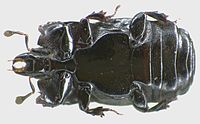Flattened stub beetle
| Flattened stub beetle | ||||||||||||
|---|---|---|---|---|---|---|---|---|---|---|---|---|

Flattened stub beetle |
||||||||||||
| Systematics | ||||||||||||
|
||||||||||||
| Scientific name | ||||||||||||
| Hololepta plana | ||||||||||||
| ( Sulzer , 1776) |
The flattened stutz beetle ( Hololepta plana ) is a beetle from the family of stutz beetles . The generic name "Hololepta" (from ancient Greek : ὁλος, hólos , "whole" and λεπτός leptós , "thin") means very flat , a property that is still characterized by the species name "plana" ( Latin planus "flat, flat") is underlined. The widespread beetle lives under the peeling bark of softwood .
Characteristics of the beetle
The beetle has a shiny black, completely flattened body that reaches a length of eight to nine millimeters.
The head is drawn into the fore chest up to the eyes and cannot be withdrawn any further. Correspondingly, there is no arched plate-like enlargement of the front breast on the ventral side (throat plate), which usually protects the mouthparts of the beetles when they retract the head (Fig. 1). The upper jaws are slender, of the same length, slightly curved on the sides and only curved more inward towards the tip. The jaw buttons are four-part and thread-shaped, the short lip buttons are three-part. The antennae consist of a slender basal segment that is bent backwards at the base and then slightly curved backwards. This is followed by the seven-parted long reddish flagellum, bent to the front, which widens outwards and ends in a three-part, flattened end button. The multi-section of the club is concealed by the fit and hair (Fig. 2).
The pronotum, which is finely rimmed on the side, is cut out at the front edge, first widens sharply towards the rear and then becomes a little narrower towards the base. The base is curved outwards.
The wing-coverts are smooth and bare and, apart from rudiments at the base of the wing, are not striated. As with all truncated beetles, they are truncated at the back, but not perpendicular to the body axis, but shorter at the wing seam than on the side of the wing covers. The last two abdominal segments are not covered by the wing covers.
The rails are widened on all legs and serrated on the outer edge, the front rails are four-toothed. The front rails are not drawn out like teeth on the inner edge. The tarsi are all gracefully slender, five-limbed and red-brown. The penultimate visible (sixth) abdominal segment (propygidium) lies in one plane with the wing covers and pronotum.

|

|
| Fig. 1: underside | Fig. 2: Sensor |
biology
Larvae and adults live predatory under the bark of deciduous trees, mainly poplars .
distribution
The beetle is a widespread species that occurs almost all over Europe.
literature
- Heinz Joy, Karl Wilhelm Harde, Gustav Adolf Lohse: The beetles of Central Europe . tape 3 . Adephaga 2 - Staphylinoidea 1. Goecke & Evers, Krefeld 1971, ISBN 3-87263-015-6 .
- Gustav Jäger (Ed.): CG Calwer’s Käferbuch . K. Thienemanns, Stuttgart 1876, 3rd edition
Individual evidence
- ↑ a b Hololepta plana at Fauna Europaea. Retrieved January 20, 2011
- ↑ Sigmund Schenkling: "Explanation of the scientific beetle names"